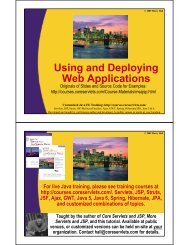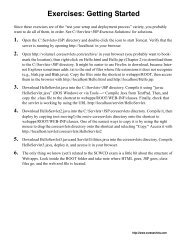JSON-RPC - Custom Training Courses - Coreservlets.com
JSON-RPC - Custom Training Courses - Coreservlets.com
JSON-RPC - Custom Training Courses - Coreservlets.com
You also want an ePaper? Increase the reach of your titles
YUMPU automatically turns print PDFs into web optimized ePapers that Google loves.
<strong>RPC</strong> and <strong>JSON</strong>• Idea– Let client code act as though h it is calling a method on theserver (not accessing a URL)• Advantages– Simpler client syntax• No explicit use of XmlHttpRequest object– Simpler server syntax• Regular methods, not server doGet methods– Can pass and return data directly• Instead of indirectly sending strings in (via requestparams) and printing to generate output data• Disadvantages– Requires extra code on both client and server– Ties server code to Java (instead of to arbitrary URL)7<strong>JSON</strong>-<strong>RPC</strong>• <strong>JSON</strong>-<strong>RPC</strong>– Standard dfor remote calls with <strong>JSON</strong> data– http://json-rpc.org/• jabsorb– Popular <strong>JSON</strong>-<strong>RPC</strong> implementation• “JavaScript to Java Object Request Broker”– Simple to use; limited power– Installation and setup poorly documented• Other <strong>JSON</strong>-<strong>RPC</strong> implementations– http://json-rpc.org/wiki/implementations• Alternative <strong>RPC</strong>-to-Java toolkits– Google Web Toolkit (covered later in this tutorial)t – Direct Web Remoting (http://directwebremoting.org/)8
13Registering Handler Object onServer• Idea– You instantiate i a server-side object and register it (give aname). E.g., give it the name objName.• Use init of servlet with load-on-startup or context listener– For synchronous class, client code callsrpcClient.objName.methodName(args)• Very useful for interactive testing; do not use for final app.– For asynchronous calls, client code callsrpcClient.objName.methodName(callbackFunction, args)• Alternatives– If you have static methods only, you can register class– If methods have state, ,you can make a user-specifichandler object that is stored in the user’s session• There is good documentation on this at jabsorb.orgSample Handler Objectpublic class JsonRpcTester {public double getRandomNumber() {return(Math.random());}public double getRandomNumber(double range) {return(range * Math.random());}14public City getCity(String cityName) {return(CityUtils.getCity(cityName));( }}• Note– This is normal object with normal methods, not a servlet
Registering Handler Object onServer: Servlet Context Listenerpackage coreservlets;import javax.servlet.*;import org.jabsorb.*;public class JsonRpcInitializerimplements ServletContextListener {public void contextInitialized(ServletContextEvent event) {JsonRpcTester rpcTester = new JsonRpcTester();<strong>JSON</strong><strong>RPC</strong>Bridge globalBridge =<strong>JSON</strong><strong>RPC</strong>Bridge.getGlobalBridge();globalBridge.registerObject("rpcTester", rpcTester);}}public void contextDestroyed(ServletContextEvent event) {}15Registering Handler Object onServer: web.xml Entrycoreservlets.JsonRpcInitializer16
© 2010 Marty HallClient-SideConfiguration<strong>Custom</strong>ized Java EE <strong>Training</strong>: http://courses.coreservlets.<strong>com</strong>/Servlets, JSP, JSF 2.0, Struts, Ajax, GWT 2.0, Spring, Hibernate, SOAP & RESTful Web Services, Java 6.Developed and taught by well-known author and developer. At public venues or onsite at your location.Registering <strong>RPC</strong> Client inBrowser• Idea– Client loads jsonrpc.js in page– Client does• rpcClient = new <strong>JSON</strong>RpcClient("address");– Address is from the URL pattern that you set in web.xml(e.g., /<strong>JSON</strong>-<strong>RPC</strong>)– For synchronous calls• rpcClient.serverObjName.methodName(args)– Never deploy real apps with synchronous calls, but this istremendously useful for interactive testing in Firebug. You candirectly type in remote method calls and make sure everythingworks before hooking it up to callback handler for the real app.– For asynchronous calls• rpcClient.serverObjName.methodName(callback, args)18
Registering <strong>RPC</strong> Client inBrowser: Examplevar rpcClient;window.onload = function() {rpcClient = new <strong>JSON</strong>RpcClient("<strong>JSON</strong>-<strong>RPC</strong>");}This is relative URL. This example assumesthat page is in top level of Web application. Ifit was in subfolder, you would use ../<strong>JSON</strong>-<strong>RPC</strong>. If you used this from pages scattered invarious subfolders at different levels, youcould do /appName/<strong>JSON</strong>-<strong>RPC</strong>.19© 2010 Marty HallMaking SynchronousRemote Calls<strong>Custom</strong>ized Java EE <strong>Training</strong>: http://courses.coreservlets.<strong>com</strong>/Servlets, JSP, JSF 2.0, Struts, Ajax, GWT 2.0, Spring, Hibernate, SOAP & RESTful Web Services, Java 6.Developed and taught by well-known author and developer. At public venues or onsite at your location.
Synchronous <strong>RPC</strong> Calls21• Idea– Make normal function call• var result = rpcClient.serverObj.methodOfServerObj(…);• Arguments to method and return value– You can pass numbers, strings, arrays, or objects.– You do not need to escape Strings you pass to server– Beans that are returned from server are automatically<strong>JSON</strong>ified as in previous lecture– Passing objects to server is trickier (but not done often).Server-side sdecode should expect <strong>JSON</strong>Object.• Important: use asynchronous calls– Synchronous calls are only for practice and testing of theserver-side side code.– Always use asynchronous calls in real life, otherwiseJavaScript will be frozen until server returns.Synchronous Calls: Example ofInteractive Testing22First, deploy app and start server. Bring up a page that loads both jabsorb.js and a JavaScript file that does basic client-side setup as justdescribed. Then bring up Firebug and interactively try out remote method calls. To add a new remote method, just add a method to the class inEclipse and save file. Then R-click on server and choose “Restart”. Then go to HTML page and hit reload button. Then go back to Firebug andtry the new method.
Synchronous Call: Example(JavaScript)function showRandomNumber1(resultRegion) {var randomNumber =rpcClient.rpcTester.getRandomNumber();htmlInsert(resultRegion,"Number is " + randomNumber);}23Synchronous Call: Example(HTML)text/javascript …Synchronous Server Call24
Synchronous Call: Example(Result)25© 2010 Marty HallMaking AsynchronousRemote Calls<strong>Custom</strong>ized Java EE <strong>Training</strong>: http://courses.coreservlets.<strong>com</strong>/Servlets, JSP, JSF 2.0, Struts, Ajax, GWT 2.0, Spring, Hibernate, SOAP & RESTful Web Services, Java 6.Developed and taught by well-known author and developer. At public venues or onsite at your location.
Asynchronous <strong>RPC</strong> Calls• Idea– When calling remote function, pass JavaScript callbackfunction as the first argument to the call– The callback function should take two arguments• The real data that will <strong>com</strong>e from the server• An exception– Callback will be invoked on readyState 4.• No freezing browser until response <strong>com</strong>e in• The exception will be undefined if everything was ok• Arguments and return values– Same as in previous example. Numbers and stringspassed ddirectly. Objects have type conversion rules.• You do not escape strings. Done automatically.27Making Asynchronous Calls:Example (JavaScript)function showRandomNumber2(inputField, resultRegion) {var range = parseInt(getValue(inputField));if (isNaN(range)) {range = 1;}var callback = function(randomNumber, exception) {if(exception) {alert(exception.msg);} else {htmlInsert(resultRegion, "Number is " + randomNumber);}};rpcClient.rpcTester.getRandomNumber(callback, range);}28Note: http://jabsorb.org/Manual says to use“exception.message”. However, debugging withFirebug shows that it is “exception.msg” in thecurrent release.
Making Asynchronous Calls:Example (HTML)Asynchronous Server CallRange (default 1):num range 29Making Asynchronous Calls:Example (Result)30
© 2010 Marty HallPassing or ReturningComplex Data<strong>Custom</strong>ized Java EE <strong>Training</strong>: http://courses.coreservlets.<strong>com</strong>/Servlets, JSP, JSF 2.0, Struts, Ajax, GWT 2.0, Spring, Hibernate, SOAP & RESTful Web Services, Java 6.Developed and taught by well-known author and developer. At public venues or onsite at your location.Complex Data• Data sent to server– Numbers and strings need no special handling• Do not escape strings.• This is done automatically.– Objects can be sent only if server expects <strong>JSON</strong>Object• Data returned from server– Numbers and strings need no special handling– Returned objects are automatically passed to <strong>JSON</strong>Objectconstructor• Which means you can easily return beanswithout explicit conversion32
Returning Complex Data:Example (Server Code)package coreservlets;public class JsonRpcTester {public double getRandomNumber() {return(Math.random());random());}public double getRandomNumber(double range) {return(range * Math.random());}}public City getCity(String cityName) {return(CityUtils.getCity(cityName));}35Returning Complex Data:Example (HTML)Returning Complex DataCity Name:36
Returning Complex Data:Example (Results)3738Complex Data: Returning Listsor Arrays• Server-side code– Specify return type as List or Type[]• Client-side code– Get the “list” property (not the direct return value)– This is an array (probably of <strong>JSON</strong>ified beans)• Examplevar callback = function(cityList, exception) {if(exception) {alert(exception.msg);} else {doSomethingWith(cityList.list);}};Note: http://jabsorb.org/Manual says to use“exception.message message” . However, debugging withFirebug shows that it is “exception.msg” in thecurrent release.Even though remote method returns List, theconverted List (array) does not go into the top-levelvariable (cityList). Instead, it gets put into anautomatically-created property called “list”.
© 2010 Marty HallWrap-up<strong>Custom</strong>ized Java EE <strong>Training</strong>: http://courses.coreservlets.<strong>com</strong>/Servlets, JSP, JSF 2.0, Struts, Ajax, GWT 2.0, Spring, Hibernate, SOAP & RESTful Web Services, Java 6.Developed and taught by well-known author and developer. At public venues or onsite at your location.Summary• Register server handler object– <strong>JSON</strong><strong>RPC</strong>Bridge.getGlobalBridge(name, object);• Make browser <strong>RPC</strong> client– rpcClient = new <strong>JSON</strong>RpcClient("address");• Make synchronous call (testing only!)– rpcClient.serverObj.methodName(args)• Make asynchronous call– rpcClient.serverObj.methodName(callback, llb args)• Returning bean from server– Return it directly. Converted automatically ti with<strong>JSON</strong>Object as shown in previous tutorial section.42
© 2010 Marty HallQuestions?<strong>Custom</strong>ized Java EE <strong>Training</strong>: http://courses.coreservlets.<strong>com</strong>/Servlets, JSP, JSF 2.0, Struts, Ajax, GWT 2.0, Spring, Hibernate, SOAP & RESTful Web Services, Java 6.Developed and taught by well-known author and developer. At public venues or onsite at your location.

















